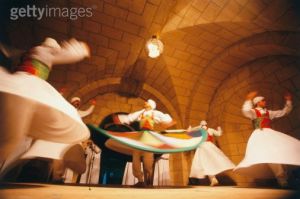A WHIRLING DERVISH
Lately I’ve been feeling like a whirling dervish…except that I’ve been getting dizzy. If you’ve ever since those Persian/Turkish dancers with their high hats, loose slacks, and robes spinning in unison, you may think, well, of course they’re getting dizzy. But the aim is ironically the opposite; they’re surpassing dizzy.
 Dervishes are like Christian Orders. Among the Catholics, there are Franciscan Friars (which I would have been if I had been male), Dominicans, Jesuits, Paulists, and Benedictines. The Sufis (the mystics of Islam) have their fraternal orders as well and these are called Dervishes. Among some of the more important dervishes are the Qadir, Rifa’i, Shadhili, Suhrawardi, and the Mevlevi. Like their Christian, Hindu, and Buddhist (known as sadhus) counterparts, individuals within the discipline of a dervish are practicing asceticism or a chosen simplicity and poverty, what the Sufis call tariqa (the path, the way to God).
Dervishes are like Christian Orders. Among the Catholics, there are Franciscan Friars (which I would have been if I had been male), Dominicans, Jesuits, Paulists, and Benedictines. The Sufis (the mystics of Islam) have their fraternal orders as well and these are called Dervishes. Among some of the more important dervishes are the Qadir, Rifa’i, Shadhili, Suhrawardi, and the Mevlevi. Like their Christian, Hindu, and Buddhist (known as sadhus) counterparts, individuals within the discipline of a dervish are practicing asceticism or a chosen simplicity and poverty, what the Sufis call tariqa (the path, the way to God).
All dervishes do not whirl. Each order follows the practices of its founder. The Franciscans follow St. Francis of Assisi, (the charismatic nobleman and soldier who gave up everything save God), wearing rough, plain garments, they live completely by alms, and serve the poorest of humanity and the needs of animals. In Egypt, the Qadiryya dervish, also live humbly and give to the poor, but what sets them apart, is they are mostly comprised of one profession, they are fishermen. Interesting to note, the more we are different, the more we are the same. There was another famous fisher of men in Galilee, a Jesus of Nazareth, whose apostles were also fishermen. I guess you could say in some ways, that Jesus was the founder of his particular dervish.
 But the dervish that whirls is the Mevlevi dervish. Founder Mevlana Jaladdin Rumi (1207-1273), the renowned mystic and prolific poet included the trance-like dancing as part of his practice of tariqa. Rotating in a precise rhythm, the dance is part of a sacred ceremony. The dancer represents the earth revolving on its axis while orbiting the sun. The purpose of the ritual is to empty oneself of all distracting thoughts. Entering a meditative state, the body conquers dizziness.
But the dervish that whirls is the Mevlevi dervish. Founder Mevlana Jaladdin Rumi (1207-1273), the renowned mystic and prolific poet included the trance-like dancing as part of his practice of tariqa. Rotating in a precise rhythm, the dance is part of a sacred ceremony. The dancer represents the earth revolving on its axis while orbiting the sun. The purpose of the ritual is to empty oneself of all distracting thoughts. Entering a meditative state, the body conquers dizziness.
There is intention. When I am spinning my wheels, with a to-do list that is attacked like putting out a fire, tangled up in a lengthy fire hose, un-intentionally wrapped around myself like a boa constrictor; I have not entered the dance mindfully, but rather stumbled onto to the dance floor befuddled. “Music is to develop the consciousness, poetry is wisdom”, said the prophet Muhammad. Music, an essential accompaniment to whirling, is repetitive and rises to a crescendo of spiritual oneness, the blurring and blending of the material and cosmic worlds.
It is also about the breath. It is bringing the body and mind just to the present.
One of the many reasons that Rumi is known and loved across faiths and cultures is that his prolific writings speak to the timeless life of the Spirit. His message speaks of NOW:
 Not Christian or Jew or Muslim, not Hindu, Buddhist, Sufi or Zen. Not any religion, or cultural system. I am not from the East or the West, nor out of the ocean or up from the ground, not natural or ethereal, not composed of elements at all. I do not exist, am not an entity in this world or the next, did not descend from Adam and Eve or any origin story. My place is placeless, a trace of the traceless, neither body nor soul. I belong to the beloved, have seen the two worlds as one and that one call to and know. First, last, outer, inner, only that breath breathing human. (Rumi Poem, Only Breath).
Not Christian or Jew or Muslim, not Hindu, Buddhist, Sufi or Zen. Not any religion, or cultural system. I am not from the East or the West, nor out of the ocean or up from the ground, not natural or ethereal, not composed of elements at all. I do not exist, am not an entity in this world or the next, did not descend from Adam and Eve or any origin story. My place is placeless, a trace of the traceless, neither body nor soul. I belong to the beloved, have seen the two worlds as one and that one call to and know. First, last, outer, inner, only that breath breathing human. (Rumi Poem, Only Breath).
Always, a returning, a turning back, no matter how many times one has strayed.


